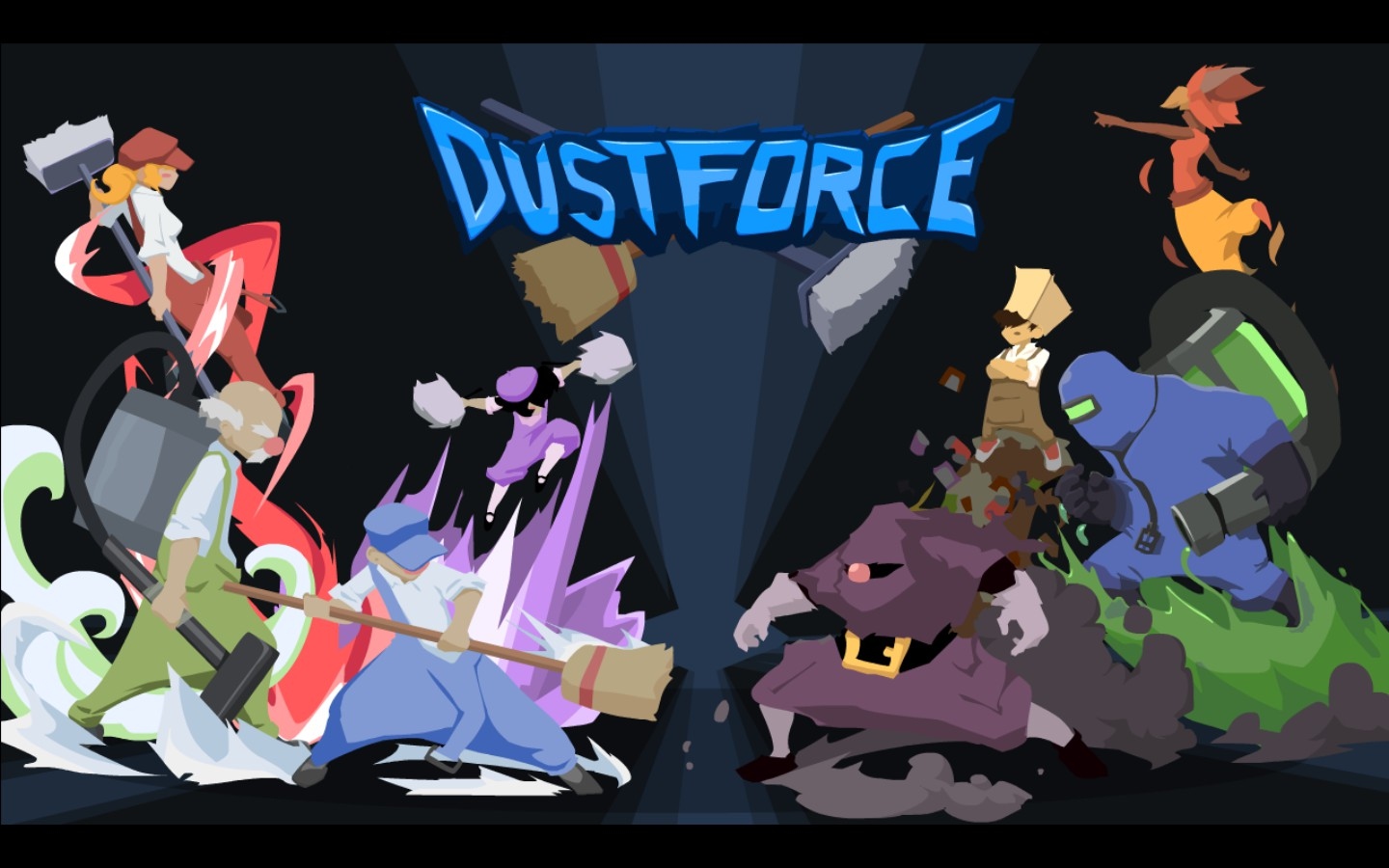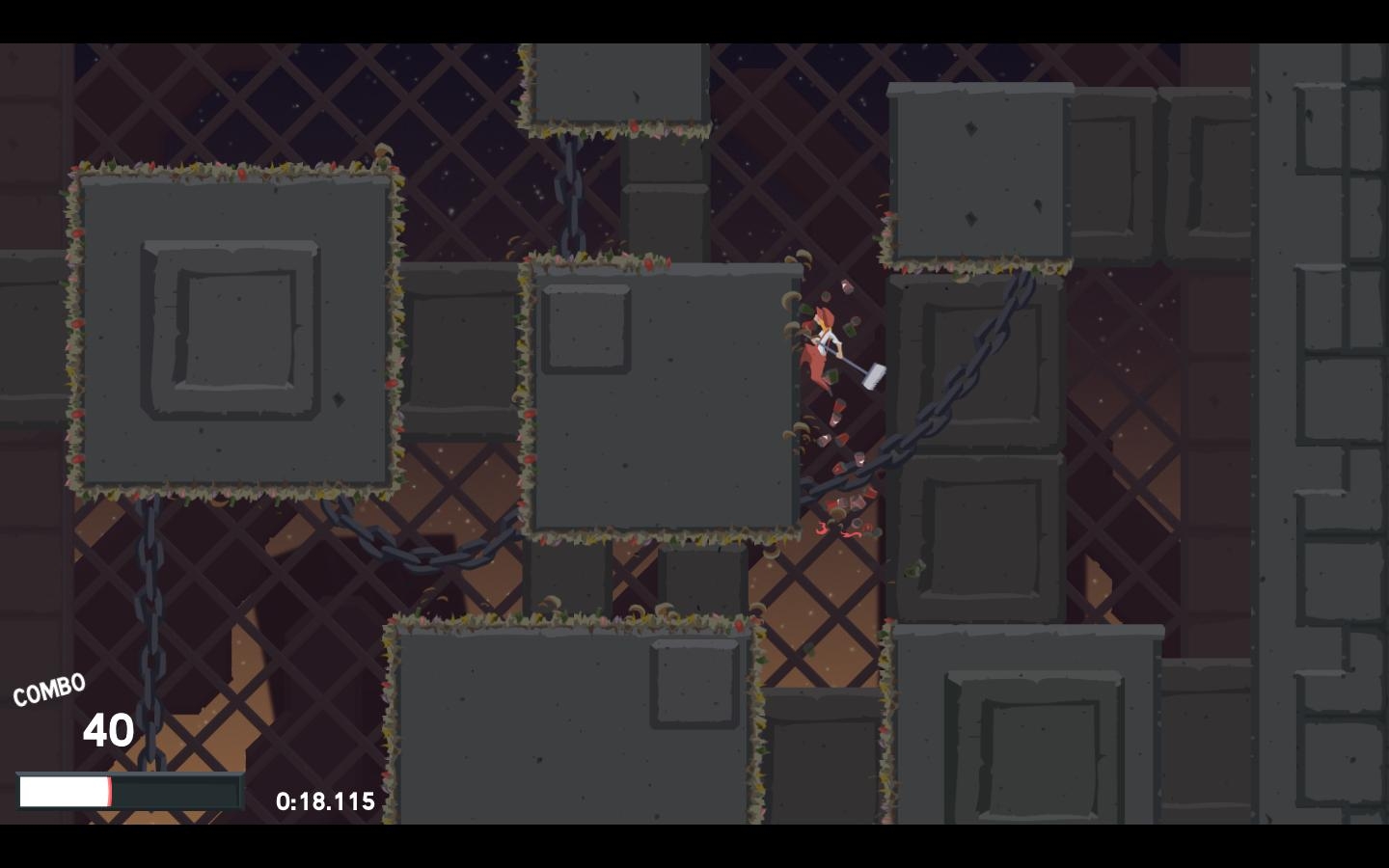In some ways I suspect a proper review of Dustforce is redundant. People will look at a gameplay video or two and immediately know if they’re going to like it, because it’s just that sort of game – the kind that has a visceral appeal to a certain type of mindset, but one that will repel others in exactly the same way – and whatever I write here is going to be unlikely to change that. But Dustforce may just be an exception to that rule, seeing as my own reaction to it surprised me quite a bit.
Dustforce is one of those bastard hard platformers in the vein of Super Meat Boy or the venerable N. You take control of one of a team of what is best described as ninja cleaners and your job is to run through a series of levels cleaning up the rubbish that inexplicably adheres to every surface. The more rubbish you clean up and the more efficiently you do it, the better a rating you’ll get at the end. However, there are several subtle features of the game (and one amazingly clever one) that make Dustforce a very distinct beast from the games that have come before it. I can probably sum their overall effect up by saying that I didn’t like Super Meat Boy very much – like LIMBO it seemed to be a game that took perverse pleasure in seeing me fail – but that I am nevertheless very much enjoying Dustforce when I really didn’t expect to.
For starters the various cleaners are ludicrously agile. There’s no tedious unlocking of abilities or characters here; you get the full whack from the very start including double jump, dashing, wall-running, wall-jumping and even ceiling-running. The control system is deceptively easy to get to grips with: you simply hold the direction you want your cleaner to move in and they will do their best to accommodate you. It has a sticky system similar to that of the Assassin’s Creed games that works far better because of the 2D nature of the levels; run into a wall by holding right and the cleaner will “stick” to it, and can then run up it by pressing up. This is a much better way of approaching movement and control than other games of its type, not least because you’re never stuck there wondering if there’s something the developers are holding back that you need to complete a level. You have all the tools; it’s up to you to use them properly.
At first getting around the various obstacles seems like simplicity itself and you’re left wondering where the challenge is. But Dustforce is just warming you up and letting you get to grips with the controls before hitting you with some of the best level design I’ve ever seen in a platformer. It’s not until the later levels that I really started to appreciate what the developers have done, but they’ve made the proper completion of many of them dependent on conserving your character’s momentum. It wasn’t often that I encountered a jump that absolutely couldn’t be made unless I went into it just so, but wasting time faffing around doing it the slow way meant that I was more likely to break my dust combo chain and lower my final level rating. The levels have been tuned, for lack of a better word, and they’ve been tuned in such a way that most of them allow a middling player to at least get through them after much trial and tribulation, but a good player who can read the various obstacles and knows what their character is capable of can tear through it sickeningly quickly.
This is as good a time as any to mention the really clever thing Dustforce does. Say you’ve just unlocked a new level and you’ve gradually found your way through it, dying many times (Dustforce gives you unlimited lives and is generous with its checkpoints, with the caveat that every death will, as ever, lower your level rating) but eventually struggling your way to the end. A scoreboard will pop up telling you how your pathetically awful run through the level compared with everyone else’s, and displaying the top ten fastest completions. That’s par for the course in a game like this, and since the first run of a level is invariably very bad the usual result is to make the player feel small and insignificant compared to the 2,000 players who completed it more quickly than they did. However, Dustforce doesn’t want you to feel small and insignificant. Dustforce doesn’t ever want you to look at an obstacle and think “Well, how the hell do I do that?” And so its solution is to turn the scoreboard into a valuable learning tool. Other games would let you view a replay of your own woeful performance just to rub in how terrible you are. Dustforce lets you view replays of every other player on the scoreboard.
I really can’t understate how tremendous this one single feature is. It completely changes how the game works. No longer does playing a particularly hard level make you feel like you’re trying to smash through a brick wall with your head; if you’re having difficulty, you just look at the #1 player on the board to see what they did. They’re usually preternaturally good at the game and faster than you can ever hope to be, but just looking at their runthroughs is invaluable for learning the various tricks for getting through levels quickly and successfully. Dustforce may be rather difficult at times, but at the end of a day it is a game that works with the player, not against them, and one which genuinely does want you to improve your skills so that you can tackle the really hard job of getting a perfect double S rating.
Dustforce rates your level performance in two areas: Completion and Finesse. Completion is a simple matter of how much rubbish you sweep up; getting every last speck of dust in the level will result in an S rating. Finesse is the awkward one because it’s a measure of how well you do this. Every bit of rubbish swept raises your dust combo meter. Go too long without sweeping rubbish and the combo meter will reset to zero, lowering your finesse rating. Getting hit by enemies, touching spikes, falling down bottomless pits etc. will also lower your finesse rating. Getting an S rating in Finesse requires a run where you never break the combo meter and you never get hit. Getting a double S rating therefore requires a terrifying level of precision, but it’s usually something that you feel is almost within your grasp after a few runthroughs. And this is a good thing, because it’s here that we come to the one element of Dustforce’s design that has a question mark hanging over it.
Dustforce is based around a typical level hub with a number of doors leading to the various levels. The game starts with about twenty of these levels accessible to the player, with the rest being locked up tight with either silver or gold locks. Getting a perfect score on one of the base levels awards a silver key, which unlocks a silver door, which leads to a harder level. A perfect score on that grants a gold key, which gives you access to levels that have apparently been designed by Kafka. I have to say I’m not entirely comfortable with a game that requires perfection before it will let you progress. I understand the developer’s argument that getting a perfect score on a base level is about as difficult as simply completing a silver level (and they are correct in saying so) but I think what this means is that, for all its attempts to accommodate the player and make their lives easier, Dustforce has a difficulty curve that is still a little too steep. I was able to finish many of the silver levels and I even got SS ratings on some of them, but the gold levels were completely beyond me even after viewing several successful playthroughs. Perhaps what was required here was an intermediate level between silver and gold that could be accessed by getting AA ratings on the silver levels; this would keep the player striving for perfection while rewarding them for coming up just a bit short and training them to cope with the increased challenge found in the gold levels.
Nevertheless I’ve had a lot of fun with Dustforce. That’s not bad going for a title I knew nothing about and bought purely on the basis of its art and its insane premise of ninja sweepers (also because the baddies kind of reminded me of Jet Set Willy). It’s by far the most accessible platformer of its type that I’ve played, so if you enjoyed Super Meat Boy at all – or even if you found it somewhat mean-spirited, like I did – it’s probably worth giving it a go; if not now, then when it inevitably goes on sale for pennies. It’s a fine game and an outstanding example of the genre.






In response to your caption comments I do read them and even went back through previous blog entries to read any I missed. I am very disappointed with your early picture captions.
I hadn’t quite decided on alt text or proper captions when I started this blog. I was young and foolish then.
I think we’ve all grown since you started this blog. It’s been a wild ride for sure.